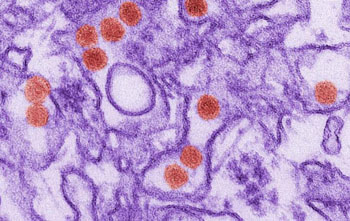Optimized Tests for Highly Reliable Diagnosis of Zika
By LabMedica International staff writers
Posted on 24 May 2016
Upon finding that several conventional Zika virus tests are not sufficiently reliable, scientists have developed and made available optimized assays as well as a control for quantifying Zika virus RNA in patient samples (blood and urine).Posted on 24 May 2016
Diagnosing viruses reliably is of major importance for individual patients and for monitoring and research on virus spread in populations. Currently, acute Zika infections are predominantly confirmed by genetic analysis. Six tests developed prior to the outbreak are currently being used. However there has been concern that numerous Zika infections are going undetected: can they detect viral RNA at very low concentrations? Are they sensitive enough to identify Zika virus strains? Are their results comparable to each other?

Image: A transmission electron micrograph (TEM) of Zika Virus particles (red) (Photo courtesy of the CDC / Cynthia Goldsmith).
A scientific team from the German Center for Infection Research (DZIF; Braunschweig, Germany) and the University of Bonn (Bonn, Germany), led by Prof Felix Drexler and Prof Christian Drosten, has now carefully examined the existing tests and developed optimized assays. The team previously developed the globally used, standardized test for the MERS pathogen.
All currently used PCR assays test for Zika virus RNA; they differ especially in examining different regions. PCR tests are suitable for early virus detection in the first weeks after onset of symptoms, whereas serological tests for patient antibodies to Zika virus are recommended for use after the 8th day.
Toward minimizing diagnostic uncertainties, the team initially compared the commonly used PCR tests for sensitivity. The comparison confirmed the concerns: that some of the tests were not sensitive enough to detect low concentrations of viruses. Additionally, not all virus strains are detected uniformly across the testing systems. Comparability between the assays is limited. The researchers assume that, depending on the system, 20-80% of patients may be incorrectly diagnosed, if serological testing methods are not used for further analysis.
The team consequently developed two optimized PCR tests, as well as a “calibrator” control that not only validates each test but also quantifies the viral RNA in the sample. The calibrator is synthetically constructed RNA that contains all the different viral RNA target zones used in the different conventional PCR tests.
"With our study, we especially wanted to call attention to the fact that a negative PCR test is not necessarily reliable," explained Prof. Drexler. The researchers have already made their results freely available prior to publication on the World Health Organization (WHO) server. The test protocols and calibrator can be ordered free of charge. The project was supported by DZIF and the European Union. In such outbreak situations, all parties involved should exchange data as early as possible and have access to the best diagnostic tools available.
The study, by Corman VM et al, was published online April 19, 2016, in the Bulletin of the World Health Organization.
Related Links:
German Center for Infection Research
University of Bonn







 Analyzer.jpg)






